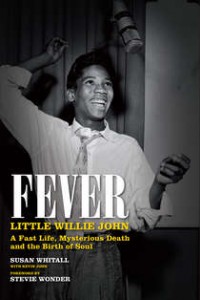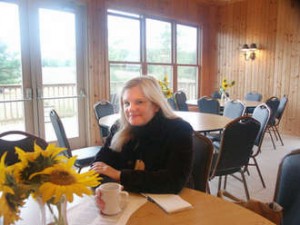MUSIC MONDAY: Meet “Fever”‘s Susan Whitall! (Pt. 2 of Q&A)

Fever: Little Willie John, A Fast Life, Mysterious Death and the Birth of Soul by Susan Whitall with Kevin John
Welcome to MUSIC MONDAY! Today, we are featuring Part 2 of our two-part Q&A with author and music critic SUSAN WHITALL. If you missed Part 1, the link is here: https://paulayoo.com/blog/?p=1000
I worked with Susan at The Detroit News in the early ’90s. She was a fantastic writing mentor to me, and we would have very long phone and email chats about how much we loved music!
Susan’s latest book is Fever: Little Willie John, A Fast Life, Mysterious Death and the Birth of Soul (Titan Books 2011). In our two-part Q&A, we’ll be chatting with Susan about the iconic Little Willie John, the music industry, music journalism, and how Little Willie John’s influence led to the birth of soul music. Part 2 of our Q&A also focuses on her music journalism career for all you aspiring writers and rock critics out there!
We are also hosting a signed book giveaway contest. A winner will be chosen at random to receive a signed copy of Susan’s book FEVER! To participate, please post a comment in either Music Monday blog or email me at paula at paulayoo dot com to have your name included in the drawing. Winner will be announced on Monday October 24, 2011. Good luck!
To find out more about Susan, please visit her website here: http://www.susanwhitall.com/
(Keep reading after the jump for Part 2 of our Q&A with “FEVER” author/music critic SUSAN WHITALL!)
Part 1 of Q&A with SUSAN WHITALL
Susan Whitall’s bio (from her website http://www.susanwhitall.com/):
Susan Whitall was one of a handful of women on staff at the brash, irreverent Creem Magazine in the mid-1970s, the rock journal immortalized in Cameron Crowe’s film “Almost Famous.” In the late ’70s she became one of the first women to edit a national rock magazine when she took over the top editor’s job.
She is the author of “Fever: The Fast Life and Mysterious Death of Little Willie John and the Birth of Soul” (Titan Books, June 2011), a biography of one of the greatest R&B singers to come out of Detroit, a favorite of Marvin Gaye, B.B. King and Aretha Franklin, best friends with Levi Stubbs and Jerry Butler.
“Women of Motown,” numerous feature articles for magazines and newspapers, and liner notes for albums, including the booklet essay in the “Chrome Collection” Spinners box set.
Since the 1980s Susan has been a feature writer for the Detroit News, writing about pop culture, music and radio, often returning to stories about the R&B and soul music that came out of the Motor City.
Joined by jazz writers Lars Bjorn and Jim Gallert and R&B expert S.R. Boland, Susan gives talks on the history of Detroit music. Most recently the foursome were featured speakers in the Jazz Talk Tent at the Detroit International Jazz Festival.
Q&A – Part 2 of 2
— Q: It’s interesting how music is now distributed – new bands are being discovered at random on youtube, songs are made popular through commercials and as background music on TV shows, and streaming stations and apps like iTunes and Pandora are the new “deejays” when it comes to recommending new music based on people’s previous purchases online. Do you think this has helped or hurt new bands trying to “make it” in today’s increasingly niche-ified music market?
— A: It’s both helped, and hurt young musicians — I know, a cop-out of an answer. But it’s like what writers face. You don’t have a monolithic publishing industry necessarily, you can (and have to) do your own marketing, but on the other hand you don’t have to go through the portals of a major corporation in order to have your music heard.
Then again…to get your music heard by a large number of people, or to get the best book distribution, the old-economy way is still the best. A large record company, a mass market TV show, a big-name publisher. Best thing is to get traction as an indie artist, then picked up by the bigs.
— Q: Because you are a journalist, I was wondering what your creative process was for writing a narrative non-fiction book. How do you approach all this research and turn these facts into a compelling narrative story that has a beginning, middle and end plus an engaging character arc for your main subject? How did you balance writing this book while working full-time as a Detroit News reporter? What are some of your writing influences, especially in literary/narrative non-fiction?
— A: The research part comes naturally to a journalist of course, it’s just so fun, as you know there’s a running joke in newsrooms that some of us get caught up in research and over-reporting, for the love of it. Especially with so many databases and publications digitized now, you can really open up a view of many worlds, without leaving your laptop. When I discovered the Chicago Defender online — the black newspaper — wow, this was great. Vintage newspapers, especially ones in niches like African-American papers, are just treasure troves of daily life that have been overlooked by mass media. Then I found a lot of lesser-known newspapers, and thanks to a friend who works at ProQuest in Ann Arbor, was able to track down some of the more obscure, but digitized ones. Saved me a trip to the University of Michigan graduate library!
As for structuring the narrative, I’m a geek about reading both fiction and nonfiction, have been all my life, and had the excuse of being an English literature major to continue on that path in college. So I have a foot in both camps (fiction and nonfiction). And I think instinctively that makes you see the narrative arc in the raw material of someone’s life. In the case of Willie, from the description of his friends I knew he was a colorful figure, and the drama of his life was so pronounced, it wasn’t hard at all to see where the narrative sped up to a crushing denouement. But it’s just like fiction, you have to structure and write keeping in mind the attention span and pleasure of the reader. So taking the raw, true facts, you still have leeway in what you emphasize, and how you structure the dramatic exposition. At that point it becomes like writing a novel, and it’s great fun. It’s the part of writing where you’re burrowed in, not paying attention to anything else, but having a lot of fun.
Whenever I see someone (including top literary writers) say writing is painful for them, I think, uh-oh. And of that Gore Vidal quote about writer’s block, I’m paraphrasing, but something like, “If it’s that hard, get out of the way, there’s plenty more where you came from.” Seriously, if it’s not fun, why do it?
Writing influences: I think a lot of brilliant writers are in the mystery genre right now, I love James Lee Burke for the poetry of his descriptions, of people, animals, natural phenomena. My former colleague Nick Tosches, who wrote the “Unsung Heroes of Rock and Roll” column for Creem Magazine, and went on to write many books, including the Dean Martin biography “Dino,” was writing creative nonfiction before they named it thus. He has a particular gift for making a long-gone era come alive. Now of course he’s writing fiction almost entirely…
As for how I juggled it with a day job…in my case, a journalism job at the Detroit News. Well, my editors were great, they let me occasionally work from home, so on those days I could use the wasted hour of commuting time, to work on my book instead. Some journalist-writers told me the best time to write was in the morning, before going to work. But I think you have to do what’s right for you as an individual. Maybe it was the topic, but I found late night to be better for me. Weekends were best of all because I felt fresher. It was hard to write so much, between the News and the book it made my tendonitis flare up a bit, on the other hand, it’s a different sort of writing altogether, so it exercised a part of my brain that I don’t always get to use (long-form writing).
— Q: We first met as reporters for The Detroit News. I had read a ton of CREEM magazines as a teen and was so excited to discover you had written and edited for the magazine. Back in the mid ’70s, women rock journalists and critics were a rare sight compared to today. What was it like for you being one of just a handful of women to write (and later edit) one of the most influential rock music magazines? Do you think times have improved since then for women journalists, especially in the music industry? If not, why?
— A: Yes things have gotten better for female journalists, because of the changes in the broader culture. When I got out of college, in the mid-’70s mind you, scratching to get an ad writing job at an ad agency, the guy hiring actually said these words: “We start all our girls in the secretarial pool.” I mean, right out of “Mad Men”!
Luckily I didn’t do that, but found Creem and caught on there. And fortunately, some of our male editors early on — Dave Marsh and Lester Bangs, particularly — were staunch feminists. Today there also isn’t the ever-present fear we had, of being mistaken for groupies. Today I think young women feel free enough, that it’s not a problem if they were taken for party girls. But we were very conscious of wanting to be seen as professionals, not girls looking for a good time. Thus when romantic liasons happened, it was pretty much kept on the down low (laugh)…
The male writers, on the other hand, would have been delighted. They would have bragged about it to everybody.
— Q: Please tell us about your next book projects!
— A: As for my next project, it’s among a few things and I’m not copping out by not specifying more because I will be having an in-depth talk with my agent next week. There is a wealth of material out here in the middle of the country though, I will say that.
######
Thanks Susan for a fantastic two-part Q&A!
Remember… please comment on this blog so you can be automatically included in our signed book giveaway contest. Or you can email me at paula at paulayoo dot com and request your name be included in the drawing. Winner will be announced on Monday October 24th.
Also – please come back for this week’s FOODIE FRIDAY blog (10/14/11) for part 2 of our two-part Q&A with cook/author/food critic DOMENICA MARCHETTI. (We’re also hosting a signed book contest drawing for her as well – check out this week’s Foodie Friday blog for more details on how to participate.)
Until the next blog, as always… Happy Writing! WRITE LIKE YOU MEAN IT! 🙂

2 Responses
The book sounds very interesting, and I’ll have to put it on my “must read” list. I don’t know much about Little Willie John, but I’m certainly a big fan of the people he influenced and befriended, so I’m sure I’ll be a fan soon.
Thanks Skip! Definitely check out LWJ’s music on youtube, there’s a Beatles cover of one of his songs that’s amazing and shows his influence on them. You’re also included in our drawing for her signed book. Good luck!
Comments are closed.